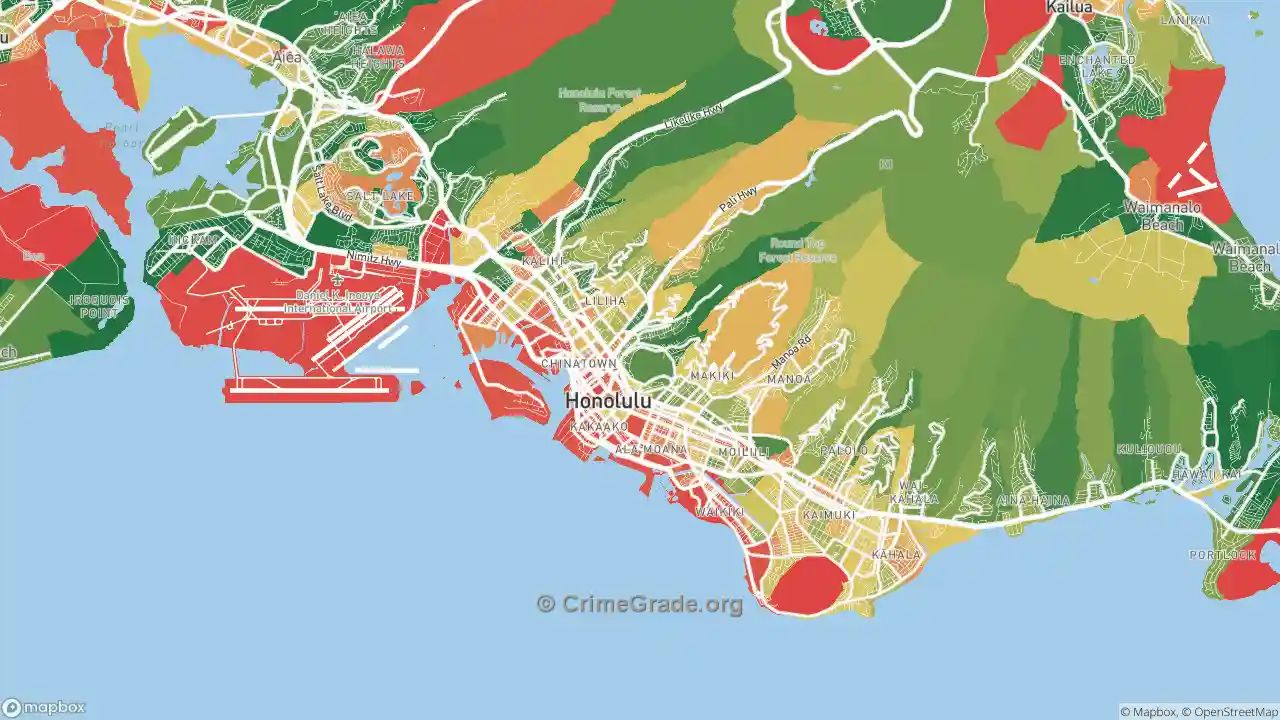Honolulu County, also known as the City and County of Honolulu, stands as Hawaii’s most populous county and serves as the state’s capital. It encompasses the entire island of Oahu, along with several smaller islands and atolls. Around 974,000 people call Honolulu County home, ranking it as the 13th most densely populated county in the United States.
While renowned for its stunning beaches, diverse culture, and thriving tourism sector, Honolulu County is not exempt from crime and violence. In 2020, Honolulu County reported a total of 41,915 crimes, with 3,140 classified as violent crimes and 38,775 as property crimes, according to FBI data. The overall crime rate in the county was 4,304 per 100,000 residents, slightly surpassing the national average of 3,719 per 100,000 residents.
Nonetheless, safety levels in Honolulu County’s neighborhoods vary. Some areas experience higher rates of violent crimes, such as murder, rape, robbery, and assault. Utilizing information from AreaVibes and CrimeGrade, here are the five most perilous neighborhoods in Honolulu County as of 2023:
5. Mokapu
Mokapu, situated in the eastern region of Honolulu County, occupies a peninsula separating Kaneohe Bay from Kailua Bay. Predominantly taken up by the Marine Corps Base Hawaii, Mokapu has approximately 9,948 residents.
Its violent crime rate stands at 377 per 100,000 residents, marking a 66% increase over the Honolulu average and 48% above the national average.
Additionally, Mokapu records a high property crime rate of 4,190 per 100,000 residents, exceeding the Honolulu average by 45% and the national average by 75%. Burglary, theft, and motor vehicle theft are the most common criminal activities in this area.
4. Kalihi-Palama
Found in the central part of Honolulu County, north of downtown Honolulu and west of Liliha-Kapalama, Kalihi-Palama holds historical significance and a dense population of around 39,960.
The violent crime rate here is 378 per 100,000 residents, surpassing the Honolulu average by 67% and the national average by 49%.
Additionally, the property crime rate reaches 4,179 per 100,000 residents, exceeding the Honolulu average by 44% and the national average by 74%. Theft, burglary, and assault are the primary criminal occurrences in Kalihi-Palama.
3. Waianae
Waianae, positioned in the western part of Honolulu County along the Waianae Coast, stands as one of the more remote and secluded regions. With a population of roughly 37,608, Waianae records a violent crime rate of 379 per 100,000 residents, surpassing the Honolulu average by 67% and the national average by 50%.
Moreover, the property crime rate hits 4,184 per 100,000 residents, surpassing the Honolulu average by 44% and the national average by 74%. Theft, burglary, and motor vehicle theft constitute the primary criminal activities in this area.
2. Wahiawa
Positioned in the central part of Honolulu County between the Waianae Mountains and the Koolau Mountains, Wahiawa is surrounded by agricultural land and military bases. With a population of around 46,562, Wahiawa has a violent crime rate of 393 per 100,000 residents, surpassing the Honolulu average by 73% and the national average by 56%.
Additionally, its property crime rate reaches 4,200 per 100,000 residents, exceeding the Honolulu average by 46% and the national average by 76%. Theft, burglary, and assault are the most prevalent criminal activities in Wahiawa.
1. Airport
The Airport neighborhood, located in the southern part of Honolulu County near the Daniel K. Inouye International Airport and the Joint Base Pearl Harbor-Hickam, functions as a significant transportation and commercial hub.
Hosting about 20,331 residents, this area records a violent crime rate of 426 per 100,000 residents, surpassing the Honolulu average by 88% and the national average by 71%. Its property crime rate reaches 4,216 per 100,000 residents, exceeding the Honolulu average by 47% and the national average by 77%. Theft, burglary, and robbery constitute the primary criminal activities here.
Conclusion
These are the five most hazardous neighborhoods in Honolulu County according to the latest available data. However, it’s essential to recognize that crime rates can change over time and vary based on sources and methodologies.
As such, exercising vigilance and awareness when residing in or visiting any area is crucial. Furthermore, it’s important to remember that the positive aspects and attractions in Honolulu County outweigh the negative ones. Honolulu County offers its residents and visitors a diverse, vibrant environment filled with opportunities and experiences.

